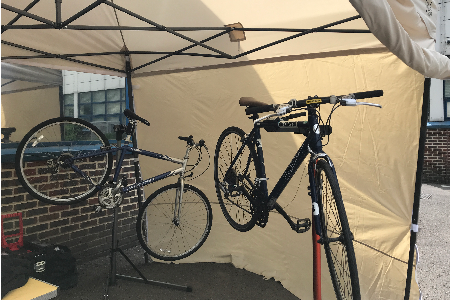
The Bike Recycling Project targets small groups of secondary school students, with the aim of teaching them bike maintenance skills. The sessions are practical and will allow the students to use their newly taught skills to repair donated bikes that are broken and unwanted. Bikes can be donated from parents, teachers, and others from the local community such as bike shops, and the police.
Pupils taking part in the project can be selected to re-engage them into school, particularly those who are not engaged due to additional needs, language barriers, or challenging behaviour, by allowing them the chance to attend a non-traditional lesson. It is important to communicate with the partner school(s) so that the correct students are being recruited, and if necessary, informal ‘interviews’ can be conducted to make these selections. These students will take ownership of this project from the very beginning and will be taught skills on how to be responsible for the project such as: IT and financial management, promotion of the project, establishing relationships with businesses, setting up trade accounts for parts, encouraging donations of bikes from the community, brand and logo design, recording project income and expenditure, managing budgets and sourcing funding, and ensuring that there is a lasting legacy of the project.
Once a bike has been fully repaired it can be resold to the community at a subsidised price – this money can then go back into the project to fund more parts, tools, bikes, etc.
Sessions should be run during school hours and run once a week, for a period of 12 weeks per group (so one school term). As this is a maintenance project, it is not weather dependant, so can be run all year round.
Target audience and engagement
• The key target audiences are secondary school students, who have been identified as benefiting from this project due to dis-engagement from the school
• Create a WhatsApp group to stay engaged with student participants
• You may also want to create a Facebook Group, where participants can share their work and ideas – this is especially important if you are targeting multiple schools – as it can encourage partnership work in the future.
Reach
• Small (10-20 participants)
• Geographically – anywhere, as there are schools everywhere!
Equipment needed
• 5-6 bikes of various sizes to start. It is expected that the students will work to get more bikes donated throughout the project
• Bike maintenance tools
• Bike parts
• Flyers and posters
Resources needed
• Project Leader
-Form a relationship with the school(s)
-Recruit participants
-Oversee the project
-Ensure students are attending the sessions
-Help the students with the additional aspects of the project (financial managements, promotion of project, getting bikes donated)
-Attend and help at all the sessions
-Ensure all funding criteria and documentation is met (if required)
-Run risk assessment for safeguarding, injuries and to identify any other concerns which may affect project delivery.
-The Project Lead should have the requisite level of CRB and understand health and safety needs (preferably First Aid trained)
• Mechanic:
-Attend all sessions to teach basic mechanics and assist with fixing bikes
-Must have the relevant qualifications
• Storage space:
-You will need somewhere to store bikes, tools and parts. Talk to the school you are delivering the project at as they should be able to offer storage space. If this is not possible, speak to a local community centre, or perhaps another local business that has storage room. Your Council may be able to provide you with information on who to contact.
Estimated project costs
Please note: this budget is based on one 12-week course at one school
• Bikes of different sizes, all donated if possible £0 - £200
• Project lead £1,700
• Mechanic £1,400
• Tools £700
• Spare parts £200
• Flyers and posters £100
Top tips/key learnings
• Ensure you leave plenty of time before starting the sessions to find a partner school and to interview and select the students for the project.
• Try to keep the sessions fun, remember these students do not work well in traditional classroom setting, so try to steer clear of this type of environment.
• Always encourage your participants to do more, help them so they can continue this project after you are gone, or even to set up their own social enterprise or business!
• It’s good to measure whether participants are more or less confident in bike mechanics, or whether they feel encouraged to try fixing bikes more. This can be done by a ‘hands up’ survey or with a questionnaire, where participants are asked to confirm or not, certain statements about their view of bike mechanics.
• Depending on the area, you could direct participants to free cycle confidence and maintenance courses – please check with your local council and organisations.
Maximising local contacts
• Talk to local businesses and organisations to get bike donations, as well as the local community, police, schools and parents.
• Engage with your council – they may be able to lend you equipment, help market the project and help secure a space.
• Talk to your participants to see if there are any other ways you can help them.
This project idea was provided by Sustrans – Facebook - Twitter - Instagram - YouTube
If you decide to run your own version of this project in your community, please email us at wcgl@groundwork.org.uk. We love to hear that we are inspiring people to walk and cycle.